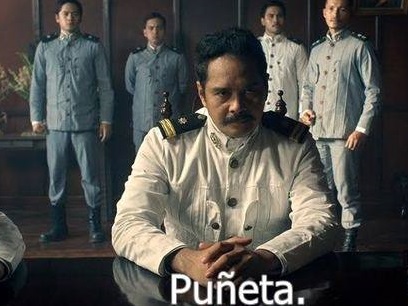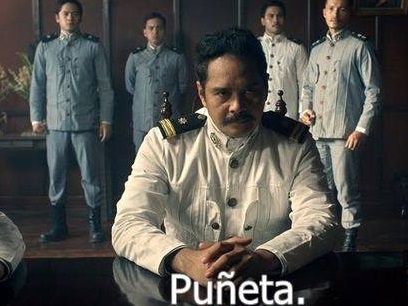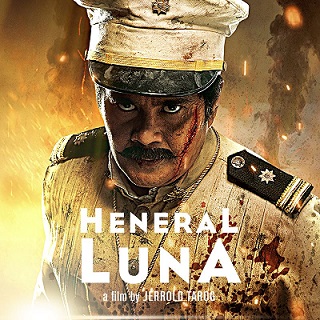
By ELLEN T. TORDESILLAS
TRANSPORTATION Secretary Joseph Emilio “Jun” Abaya is a great grandson of Emilio Aguinaldo, considered as the First President of the Philippines (1899–1901).
Aguinaldo was head of the revolutionary forces that proclaimed Philippine independence from Spain on June 12, 1898 in Kawit, Cavite.
The current box office sensation is Jerrold Tarrog’s “Heneral Luna”, a movie about Gen. Antonio Luna, the disciplinarian and temperamental commander of the Philippine Revolutionary Forces.
Tarrog’s “Heneral Luna” was based on the book “The Rise and Fall of Antonio Luna” by retired University of the Philippines Professor Vivencio R. Jose.
The most powerful scene in the movie was the brutal assassination of Luna. Scenes previous to that suggested it was on orders of Aguinaldo.
So powerful is that scene that it’s almost impossible not to hate Aguinaldo after watching it.
Interviewed Thursday on the “Heneral Luna” movie, Abaya said “I’ve read enough books, there are other versions. As to what really transpired, I don’t think he (Luna) was assassinated.”
Abaya’s comment instantly drew derision in social media reminiscent of his infamous remark about Metro Manila traffic “not fatal.”
Jowana Bueser said, “Hindi ‘assassination’? Suicide ba ang ikinamatay ni Heneral Luna?
“Mawalang galang na po Sir, hindi tulad nang pagkakaintindi mo sa trapik, ang mga sugat na natamo ni Luna ay fatal.”
Eimee C. Lagrama said: :”Paano yun? Tinaga nya sarili nya?”
Ging Villanueva Gumabay dripped with sarcasm: “Likas lang daw kasing bayolente ang pagkatao ni luna kaya’t tinaga at binaril nya ang kanyang sarili.”
So was Marilyn Robles, a Lupus patient, “Ah nakatayo kasi sa initan si Gen. Luna. Hinimatay. Nilapitan. Patay.”
Puñeta.

Abaya should read this part of the article by Mylah Roque, who interviewed the author, Jose, for VERA Files: “The scene that people would probably remember most would be the murder of Luna by soldiers from Kawit led by Capt. Pedro Janolino (Ketchup Eusebio). Soldiers took turn hacking Luna by the Cabanatuan convent. The scene is faithful to the accounts of primary sources as narrated by Jose: Luna dying with fist clenched; of the soldiers fearfully stepping back when Luna, already on the ground and dying, turned to his right; Buencamino ordering the soldiers to get all papers from his body, an old lady asking from within the convent if Luna was still moving; and of the soldiers looting the bodies of Luna and Col. Francisco ‘Paco’ Roman. One of the accounts about the killing indicated that the hacking of Luna was so violent that ‘even the intestines were already out after the undershirt had been taken off up to near the waist.’
There’s also the column by historian Ambeth Ocampo in the Inquirer titled “The way Antonio Luna died.”
Ocampo used the word “assassinated.”
Here are portions of Ocampo’s column:
“What many people do not know is that an even bigger treasure was neglected in the Heritage Art Gallery—the papers and memorabilia not just of Juan Luna but also of his brother, the ill-fated Gen. Antonio Luna, who was assassinated in Cabanatuan in 1899 by soldiers he had disarmed and discharged. These soldiers were loyal to Emilio Aguinaldo, who took most of the blame for Luna’s assassination when the list of conspirators should include others in his cabinet who wished Luna dead.
“While everyone was busy going over the Juan Luna paintings and speculating on the scads of money these would command in the art market, I was allowed to examine the boxes of papers and personal effects of which nobody took notice. In one box, for example, I saw the painting frock of Juan Luna as well as his brushes and palette. In another box, I saw the bloodied uniform of Antonio Luna that was preserved by his mother as a grisly reminder of his tragic death.
“I focused on a box that contained Antonio Luna’s papers—his student notebooks (which came complete with fine drawings of specimens he observed through a microscope) and the papers of his mature life: letters (including a batch of racy love letters from a woman named “Paquita”), parts of a journal, official military papers, etc. …
“When I was watching the film “Heneral Luna,” I waited for the assassination scene and got more than I bargained for. The violence in the last part of the movie would definitely merit an “R” rating in my book, but in the Philippines, people are more offended, or pretend to be offended, by sex in the cinema.
“I went through my notes after watching the film, and wondered why the assassins were never punished. It is odd to even think that it was a case of self-defense because it was one man against a company of soldiers. One would think that once wounded, Luna was easy to disarm and contain, but that he received more than 30 wounds from bolos and gunshots is proof that much anger was released in that killing. One or two fatal wounds would have been enough for an ordinary murder, but 30? Then, of course, we have heard of Aguinaldo’s mother watching the murder from a window in the convent and, when all was done, shouting for confirmation that Luna had indeed been killed: “Nagalaw pa ba yan?”
“Luna’s last will and test re found in his papers after his death. It is dated March 31, 1899, and written en route from San Fernando to Calumpit: “1. I leave whatever I have to my mother. 2. If they will kill me, wrap me in a Filipino flag with all the ament we clothing with which I was dressed when killed, and bury me in the ground. 3. I wish to state freely that I would die willingly for my country, for our independence, without thereby looking for death.”
“With his tragic death Luna will be remembered for a long time because the way he died continues to our time.”
Abaya should also read Ocampo’s June 15, 2015 column: “Who really ordered Luna’s murder?”
Antonio Luna not assassinated? Puñeta.

